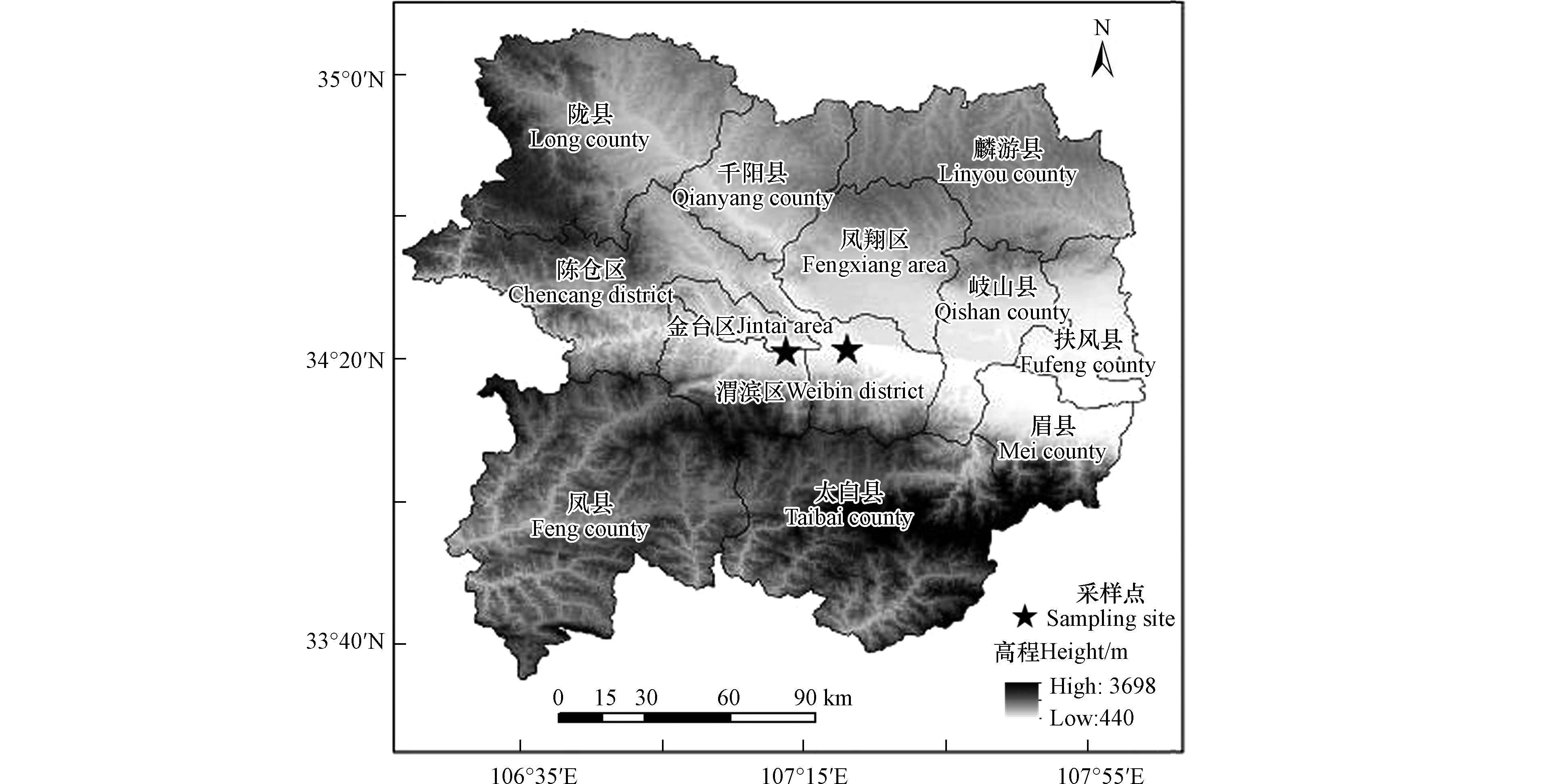-
PM2.5在空气中悬浮的时间久、输送距离远[1],对大气能见度[2]、全球气候变化[3]、人体健康及我国经济[4-6]均造成严重影响。PM2.5中主要包括碳质组分、水溶性化合物、地壳元素和各种微量元素等[7]。离子组分和其浓度变化对云和霾的形成,气候的变化都有重要影响[8-9]。研究得出,总水溶性离子浓度在PM2.5中的占比一般在20%—60%[10-12],最高可达80%以上[13],可知水溶性离子是PM2.5中较为重要的组分,且来源复杂,可作为大气污染来源的标识物[14-15],因此,研究PM2.5中的水溶性离子浓度变化特征对了解PM2.5污染物性质和来源,以及制定相关污染防治措施具有重要意义。
目前,学者对大气PM2.5中水溶性离子的研究主要集中在其浓度水平、季节变化特征、粒径分布及污染来源等方面,对不同污染等级下的水溶性离子特征研究甚少。研究区多集中在京津冀[16-17]、珠三角[18]、长三角[19]等经济较为发达的地区。对汾渭平原大气污染的研究主要集中西安[20-21]、运城[12-22]和咸阳[23],针对水溶性离子的研究主要集中在西安[24-25],对宝鸡及其他城市的研究甚少。周变红等[26]的研究表明,宝鸡市灰霾天的总水溶性离子对PM2.5浓度的贡献率及二次离子的质量浓度均高于非灰霾天。Zhao等[27]研究发现,嘉兴地区水溶性离子的浓度在PM2.5中占比为34.3%—49.6%,其中二次离子占总质量浓度的32.4%—47.0%。陶月乐等[28]研究得出成都市水溶性离子相比粗粒子则多富集在细粒子中,主要成分是(NH4)2SO4、NH4HSO4和NH4NO3。刘晓迪等[29]利用热力学模型ISORROPIA-Ⅱ得出济南市夏季和冬季PM2.5的酸度分别为5.3±1.0和4.2±1.3,表明冬季PM2.5的酸性比夏季强。高洁等[30]基于ISORROPIA-Ⅱ模型结果,研究表明,
${\rm{SO}}_4^{2-} $ 浓度对气溶胶pH值影响最大,其次是${\rm{NO}}_3^{-} $ 、Ca2+和${\rm{NH}}_4^{+} $ 。Shen等[31]基于中国东北及西北的11个城市道路扬尘和建筑扬尘的研究,表明扬尘中总水溶性离子浓度较小,并以Ca2+和${\rm{SO}}_4^{2-} $ 为主,其中几乎检测不到${\rm{NH}}_4^{+} $ 。张扬等[32]通过PMF源解析结果得出,影响南京市霾和雾形成的主导因素是二次源,同时海盐和燃烧源也是雾形成的主要来源,降水对燃煤源和二次源的清除作用在霾过程中更为明显。宝鸡市位于关中西部,不仅是关天经济区的副中心城市,还是我国的重工业基地,加之宝鸡市典型的河谷地形及较大湿度等不利的扩散条件,使宝鸡市面临严重的大气环境污染问题。本文研究了宝鸡市冬季城郊不同污染等级水溶性离子的特征及来源,以期为宝鸡市进一步开展大气气溶胶研究提供基础数据,同时为制定PM2.5污染控制措施提供相应的科学依据。
全文HTML
-
宝鸡市(106°18′—108°03′E,33°35′—35°06′N)地处关中平原西部,大陆性季风气候,年平均降水量700 mm,湿度较高,且具有南、西、北三面环山的地形特征,冬季盛行东南风有利于污染物累积,加剧污染程度。本研究于2019年11月15日至2020年1月31日,在宝鸡市文理学院(107°12′29.8″E,34°21′1.4″N)和陈仓区环保局(107°21′8.6″E,34°21′23.5″N)两个采样点进行PM2.5样品采集,采样点的空间分布位置如图1所示。文理学院位于市区,陈仓区环保局位于郊区城乡结合部,样品采集距离地面的高度均约为20 m。文理学院采样点具体设在明理楼楼顶,周围主要布局有教学楼、办公楼、居民区和两车道道路。陈仓环保局站点周围主要为城乡结合部。两个采样点周围均无高大的建筑物,地势开阔,可以客观的反映宝鸡市PM2.5大气污染状况。
-
采样前需将所使用的直径为47 mm的石英滤膜放置于马弗炉中450 ℃高温烘烤6 h,除去滤膜表面的有机物,待恢复室温后将其置于温度为(20±2) ℃,相对湿度为40%±5%中恒温恒湿箱中平衡24 h,之后使用Sartorius M5百万分之一的天平对滤膜进行称重,连续两次的称量结果须控制在误差范围之内。采样使用美国Airmetrics Minivol便携式PM2.5采样器,流量为5 L·min−1,每个样品采集时间约为23 h(当日10:00—次日9:00)。除去城区和郊区两采样点的设备故障和停电等因素,城区采集76个样品,郊区采集了75个样品,同时各采集1个空白滤膜。采样后的石英滤膜在称重后放样品盒里,并置于冰箱(−18 ℃)中保存,避免样品的污染,待离子分析。
离子分析时每个样品滤膜取其1/4放置在离心管中,加入10 mL去离子水,通过超声萃取1 h后用0.45 μm过滤器过滤,提取颗粒物中水溶性成分,并利用中国科学院地球环境研究所气溶胶化学与物理重点实验室中的Dionex-600型离子色谱仪来测定其中的水溶性离子(
${\rm{NH}}_4^{+} $ 、Ca2+、Mg2+、Na+、K+、F−、Cl−、${\rm{NO}}_3^{-} $ 、${\rm{SO}}_4^{2-} $ )。最后将离子的溶液浓度通过水量、采样流速和持续时间换算成在大气中的质量浓度[12]。 -
(1) ISORROPIA-Ⅱ模型
ISORROPIA-Ⅱ模型是基于热力学原理,计算气溶胶水含量中氢离子的浓度[33]。该模型通过8种离子(即
${\rm{NH}}_4^{+} $ 、Ca2+、Mg2+、Na+、K+、Cl−、${\rm{NO}}_3^{-} $ 、${\rm{SO}}_4^{2-} $ )的质量浓度值,以及同时间段内对应的环境温度和湿度作为基础输入数据。最终通过模型的“forward”模式[29]计算得到输出数据:液相中H+浓度和水含量,根据这两参数来计算气溶胶的pH值。公式如(1)所示:式中,
$ {\mathrm{p}\mathrm{H}}_{\mathrm{i}\mathrm{s}} $ 是PM2.5的酸度;$ {\gamma }_{{\mathrm{H}}^{+}} $ 是H+的活度系数(假设$ {\gamma }_{{\mathrm{H}}^{+}}=1 $ );$ {\mathrm{H}}_{\mathrm{a}\mathrm{i}\mathrm{r}}^{+} $ 是单位体积空气中平衡颗粒水合氢离子的浓度,ALWC是PM2.5的含水量,$ {\mathrm{H}}_{\mathrm{a}\mathrm{i}\mathrm{r}}^{+} $ 和ALWC是利用ISORROPIA-Ⅱ模型计算得出,单位均为μg·m−3。(2) PMF源解析方法
正交矩阵因子分析法(PMF) 是目前使用较广的一种受体模型,将各化学组分的质量浓度和相对应的不确定度作为输入数据,采用最小二乘法的原理,通过寻求目标函数Q最小化的解,从而确定污染源贡献谱和污染源成分谱[34],计算公式如下:
目标函数定义如下:
不确定度计算公式:
目标函数Q计算中,
$ {e}_{ij} $ 表示第i个受体中第j种组分的残差,$ {u}_{ij} $ 表示第i个受体中第j种组分的不确定度[35]。不确定度$ {u}_{ij} $ 计算中,C为各化学组分的质量浓度,MDL为其对应的方法检测限。本文采用美国EPA PMF5.0软件对宝鸡市城郊大气PM2.5中的水溶性离子的污染来源进行定量分析。
1.1. 采样点概况
1.2. 样品采集及分析
1.3. 研究方法
-
采样期间,城郊PM2.5质量浓度变化趋势如图2所示。从时间特征来看,变化趋势基本一致。城郊日均最高质量浓度分别为274.3 μg·m−3和249.7 μg·m−3,分别是国家二级标准的3.7倍和3.3倍,最高值出现的时间均为2019年12月23日,结合气象因素可知,当天的前一周风速和湿度不断增大,使得PM2.5质量浓度也呈现不断累积升高达到最高。峰值过后,PM2.5的质量浓度骤降,城郊PM2.5质量浓度均低于国家二级标准,主要受降水的影响。城郊日均最低质量浓度分别为9.5 μg·m−3和16.9 μg·m−3,低于国家一级标准(35 μg·m−3),均为2019年11月24日,此时降水量和风速分别为13.2 mm和1.6 m·s−1,相比前后均达到了峰值,PM2.5浓度骤降达到最低值可能和雨水的湿沉降和较大风速有关。从空间特征来看,郊区PM2.5质量浓度相比城区较高些,可能是受周围受当地居民的生活方式,冬季可能利用燃煤进行采暖,农村可能存在生物质燃烧及周围工厂污染物排放的影响。
本研究根据《环境空气质量指数技术规定》(HJ 633—2012)标准,按照PM2.5质量浓度值将观测时段划分为优良日[ρ(PM2.5)<75 μg·m−3]、轻度污染[ρ(PM2.5)<115 μg·m−3]、中度污染[ρ(PM2.5)<150 μg·m−3]、重度污染[ρ(PM2.5)<250 μg·m−3]和严重污染[ρ(PM2.5)>250 μg·m−3]。城郊采样天气情况如表1所示,城、郊采样期间优良天、轻度污染、中度污染、重度污染和严重污染天数分别为:33、19、13、10、1 d和20、26、12、17、0 d。不同污染等级下城郊PM2.5质量浓度由表2所示,城区和郊区平均PM2.5质量浓度分别为(96.9±51.4)μg·m−3和(111.2±48.2)μg·m−3,分别高于国家空气质量二级标准(GB 3095—2012,75 μg·m−3)约1.3倍和1.5倍,轻度污染天和中度污染天,城区PM2.5质量浓度比郊区略高。
-
采样期间,宝鸡市城区和郊区总水溶性离子日平均质量浓度分别为(46.2±31.9)μg·m−3和(48.7±30.2)μg·m−3,分别占城郊PM2.5平均浓度的47.6%和43.8%。城郊不同污染天水溶性离子中各离子的浓度水平由高到低顺序均为:
${\rm{NO}}_3^{-} $ >${\rm{SO}}_4^{2-} $ >${\rm{NH}}_4^{+} $ >Cl−>Ca2+>Na+>K+>Mg2 +,可知PM2.5中主要的3种离子是${\rm{NO}}_3^{-} $ 、${\rm{SO}}_4^{2-} $ 和${\rm{NH}}_4^{+} $ 。${\rm{SO}}_4^{2-} $ 、${\rm{NO}}_3^{-} $ 和${\rm{NH}}_4^{+} $ 分别由SO2、NOx及NH3等气体反应转化而成,可以反映大气细颗粒物的二次污染水平[29]。城郊SNA质量浓度值分别为(41.9±30.7)μg·m−3和(43.7±28.6)μg·m−3,与宝鸡市2012秋冬季SNA质量浓度(51.5 μg·m−3)相比明显下降[36]。城郊SNA在总水溶性离子中的质量浓度占比分别为90.7%和89.7%,分别占PM2.5质量浓度的43.2%和39.3%,可见城区比郊区易受二次污染的影响,这可能与城区有较大的人口密度加之冬季较大的供暖需求,以及城区较大的车流量产生的尾气排放有关。城郊不同污染等级水溶性离子的质量浓度变化如表3所示。分析可知,
${\rm{NO}}_3^{-} $ 、${\rm{SO}}_4^{2-} $ 和${\rm{NH}}_4^{+} $ 的质量浓度随着污染加重不断升高,其城区平均质量浓度均高于郊区。${\rm{NO}}_3^{-} $ 质量浓度最高,始终占据主导地位,城郊不同污染等级平均质量浓度分别为(22.2±17.6)μg·m−3和(21.3±15.0)μg·m−3。污染加重,对PM2.5的贡献越来越大,城区由优良天的15.3%增加到严重污染天的30.9%,郊区由优良天的11.7%增加至重度污染的23.3%。${\rm{NO}}_3^{-} $ 主要通过汽车尾气排放的NOx经过非均相氧化反应在气溶胶表面形成[37]。城区${\rm{NO}}_3^{-} $ 质量浓度在严重污染日、重度污染日、中度污染日和轻度污染日相较优良日分别增加了2.4、3.6、4.0、9.0倍,郊区在重度污染日、中度污染日和轻度污染日相较优良日分别增加了增加1.4、2.9、5.3倍,可知城区相比郊区空气质量受汽车尾气排放的影响较大。${\rm{SO}}_4^{2-} $ 质量浓度次之,${\rm{SO}}_4^{2-} $ 主要是由SO2通过光化学过程和液相过程反应生成[16],对PM2.5的贡献由城区优良天的10.9%增加到严重污染天的12.5%,郊区由优良天的10.4%增加至重度污染的11.8%,尽管秋冬季有燃煤供暖使得SO2浓度升高,但${\rm{SO}}_4^{2-} $ 对PM2.5的贡献却低于${\rm{NO}}_3^{-} $ ,可能由于冬季较低的温度和湿度限制了SO2转化为${\rm{SO}}_4^{2-} $ 。${\rm{NH}}_4^{+} $ 通常是由来自植物活动排放、动植物腐烂的排放、土壤微生物排放在大气中的氨气转化形成[38]。对PM2.5的贡献由城区优良天的5.2%增加到严重污染天的14.0%,郊区由优良天的5.0%增加至重度污染的11.4%。城区和郊区在优良天、轻度污染、中度污染和重度污染的SNA质量浓度分别为16.1、42.4、61.1、89.6 μg·m−3和15.7、33.4、54.0、84.9 μg·m−3,占总水溶性离子质量浓度的比例分别为82.5%、90.3%、92.5%、93.0%和81.6%、88.3%、90.7%、91.8%。城区SNA对PM2.5的贡献在优良天、轻度污染、中度污染、重度污染和严重污染分别为31.4%、42.7%、45.7%、50.5%和57.4%,郊区SNA对PM2.5的贡献在优良天、轻度污染、中度污染和重度污染分别为27.1%、34.8%、41.1%和46.5%。可知,污染越重,SNA质量浓度越大,占总离子和PM2.5的比例也越大,说明SNA对于加重大气污染有重要影响。Cl−和K+的质量浓度随着污染加重不断上升,严重污染天的质量浓度约为优良天的2.9—4.6倍。K+是生物质燃烧的标志物[39],Cl−主要来源于垃圾焚烧、海盐、燃煤和工业生产过程等[40-41],不同污染等级下的城区的Cl−和K+的质量浓度均低于郊区,这可能与城区秋冬季燃煤排放及生物质燃烧排放管控有关。随着污染加重,Ca2+、Mg2+质量浓度变化不明显,当ρ(Mg2+)/ρ(Ca2+)大于0.09时,说明Mg2+和Ca2+除了受土壤扬尘的影响还受燃煤的影响[42],城区和郊区比值分别为0.1和0.2,均大于0.09,故城郊区均受燃煤影响。
${\rm{NO}}_3^{-} $ 主要来源于移动源(如机动车)排放的NOx,${\rm{SO}}_4^{2-} $ 主要来源于固定源(如燃煤)排放的SO2。故${\rm{NO}}_3^{-} $ 与${\rm{SO}}_4^{2-} $ 浓度的比值通常作为大气污染中移动源和固定源的相对贡献强度大小的重要指标[8]。当比值大于1时表明大气污染中移动源的贡献较大;反之,则表明固定源的贡献较大[16]。有研究表明[43]在发达国家,大气污染物主要来自于汽车尾气排放,[${\rm{NO}}_3^{-} $ /${\rm{SO}}_4^{2-} $ ]一般大于1,而我国大部分地区都小于1。由图3可知,城郊日平均比值分别为1.9和1.7,均高于杭州市(0.8)[8],郑州市(1.1)[44],济南市(1.4)[45],凸显了宝鸡市秋冬季移动源对空气质量影响较大。不同污染等级城区的比值均大于郊区,说明城区受移动源的影响比郊区大,郊区可能受当地燃煤和生物质燃烧的取暖方式以及工厂等固定源的影响。郊区在优良、轻度污染、中度污染和重度污染天的[${\rm{NO}}_3^{-} $ /${\rm{SO}}_4^{2-} $ ]值分别为1.1、1.8、2.1和2.1,城区在优良、轻度污染、中度污染、重度污染和严重污染天的[${\rm{NO}}_3^{-} $ /${\rm{SO}}_4^{2-} $ ]值分别为1.4、2.2、2.5、2.2和2.5。随着污染加重,比值有升高的趋势,说明机动车尾气对大气影响的显著性会随着污染加重而增大。 -
有研究表明,
${\rm{NH}}_4^{+} $ 通常会优先与${\rm{SO}}_4^{2-} $ 反应生成(NH4)2SO4或NH4HSO4,剩余的${\rm{NH}}_4^{+} $ 和${\rm{NO}}_3^{-} $ 反应生成NH4NO3[46],故其主要以(NH4)2SO4和/或NH4HSO4和/或NH4NO3和/或NH4Cl等铵盐形式存在。由于NH4Cl有较强的挥发性[47],且相对于SNA含量较少,本研究假定宝鸡市此期间大气中NH4+主要存在形式为(NH4)2SO4、NH4HSO4、NH4NO3。${\rm{NH}}_4^{+} $ 、${\rm{NO}}_3^{-} $ 和${\rm{SO}}_4^{2-} $ 存在形式可通过NH4+浓度的计算值和实测值的相关性来确定。${\rm{NH}}_4^{+} $ 浓度的计算常用式(4)和式(5)[48],若通过式(4)计算的浓度值与实测值相关性较好,则${\rm{NH}}_4^{+} $ 、${\rm{NO}}_3^{-} $ 和${\rm{SO}}_4^{2-} $ 以NH4NO3和NH4(SO4)2的形式存在于大气中,同理,通过式(5)计算的浓度值与实测值相关性较好,则其以NH4NO3 和NH4HSO4 的形式存在。[${\rm{NH}}_4^{+} $ ]、[${\rm{NO}}_3^{-} $ ]和[${\rm{SO}}_4^{2-} $ ]分别代表各浓度值 (单位:μg·m−3)。通过两种计算方法得到宝鸡市城区和郊区的
${\rm{NH}}_4^{+} $ 浓度的计算值与实测值的相关性分别如图4和图5所示。从斜率和相关系数来看,宝鸡市城区和郊区在优良天、轻度污染天、中度污染天和重度污染天用(4)式计算的${\rm{NH}}_4^{+} $ 浓度值于实测值拟合的斜率更接近1,说明由式(4)计算得到的${\rm{NH}}_4^{+} $ 浓度值更接近于${\rm{NH}}_4^{+} $ 的实测值,由此得出宝鸡市城郊冬季不同污染等级下${\rm{NH}}_4^{+} $ 与${\rm{NO}}_3^{-} $ 、${\rm{SO}}_4^{2-} $ 均主要以(NH4)2SO4和NH4NO3的形式存在与区域大气PM2.5中。酸性是气溶胶的一个重要性质,它会影响硫酸盐[49]、硝酸盐[50] 和次生有机气溶胶(SOA)的形成[51],对生态安全、人类健康及颗粒物吸湿性均具有重要影响[52]。
${\rm{NO}}_3^{-} $ 、${\rm{SO}}_4^{2-} $ 和Cl−等阴离子形成的铵盐或者酸性液滴均可增加降水的酸性,Na+、Ca2+、Mg2+等阳离子形成的碱式盐会使降水的酸度降低。阴阳离子电荷平衡作为大气PM2.5酸碱性的重要指标[53],可定性的判断阴阳离子的相对水平,从而确定大气颗粒物的酸碱性。本文通过计算阴、阳离子电荷当量(AE)和(CE)的比值(AE/CE)来判断,比值小于1,则PM2.5呈碱性,比值大于1,则PM2.5呈酸性[16]。其中AE和CE的计算公式分别如下所示:式中,ρ指离子的质量浓度(μg·m−3),AE和CE分别为阴离子和阳离子电荷当量浓度(μmol·m−3)。
经计算得知,城区AE/CE值与其对应的R2值分别为优良日0.98(R2=0.85)、轻度污染0.93(R2=0.94)、中度污染0.88(R2=0.92)和重度污染0.87(R2=0.98)。郊区AE/CE值与其对应的R2值分别为优良日0.83(R2=0.86)、轻度污染0.87(R2=0.93)、中度污染0.92(R2=0.96)和重度污染0.90(R2=0.99),城郊不同污染等级阴阳离子相关系数均较高,说明所分析的离子可代表PM2.5中主要的水溶性组分,不同污染等级阴离子与阳离子比值均小于1,可初步判断宝鸡市冬季不同污染天城郊PM2.5偏碱性。说明宝鸡市大气PM2.5中粗颗粒物质较多,可能与局部的扬尘污染有关。此外,本文利用热力学模型ISORROPIA-Ⅱ对宝鸡市城郊PM2.5的酸度(pHis)进行计算,城郊pHis值分别为3.6±1.3和3.9±1.2,可知郊区PM2.5的酸性略小于城区。优良天,轻度污染、中度污染和重度污染天的pHis值分别为3.3±1.3、4.2±0.9、4.5±0.9和4.7±0.9,随着污染加重,PM2.5的酸性在不断减小。
-
PM2.5中水溶性离子PMF模型源解析结果如图6所示。由图6可知,因子1和2中,分别K+和Cl−的载荷最大,K+和Cl−分别是生物质燃烧和燃煤燃烧的指示物[54],故因子1和2分别可代表生物质燃烧和燃煤。因子3和因子4中载荷最大的分别为
${\rm{SO}}_4^{2-} $ 、${\rm{NH}}_4^{+} $ 和${\rm{NO}}_3^{-} $ 、${\rm{NH}}_4^{+} $ ,SNA是通过二次转化而来,可识别为二次生成[55],其中${\rm{SO}}_4^{2-} $ 和${\rm{NO}}_3^{-} $ 的前体物SOx和NOx均可与NH3在大气中发生反应生成硫酸盐和硝酸盐,因此因子3和因子4可能来源于二次生成的硫酸盐和硝酸盐。因子5中Ca2+和Mg2+载荷较大,Ca2+和Mg2+来源于土壤扬尘和道路扬尘[16],可识别为扬尘源。图7为城区不同空气质量等级下污染源类占比图,由图7可知,在优良、轻度污染、中度污染和重度污染天硫酸盐和生物质燃烧对大气PM2.5贡献比较大,是城区大气主要污染来源。污染加重,生物质燃烧、硫酸盐和硝酸盐的贡献不断增大,分别由优良日的10.4%、18.8%和6.6%增加到重度污染天的25.0%、29.9%和20.6%,相反燃煤和扬尘的贡献却不断减小,由优良天的24.3%和39.8%降低至重度污染天的17.1%和7.4%。优良天对PM2.5贡献最大的是扬尘源,随着污染加重,生物质燃烧和硫酸盐的贡献高,而扬尘的贡献却逐渐降至最低。城区不同污染源类在不同污染等级下对PM2.5贡献的平均占比由高到低依次为:硫酸盐(24.6%)>生物质燃烧(20.0%)>燃煤(19.9%)>扬尘源(19.3%)>硝酸盐(16.2%)。
图8为郊区不同空气质量等级下污染源类占比图。在优良、轻度污染、中度污染和重度污染天燃煤和生物质燃烧对大气PM2.5贡献较大,是郊区大主要污染来源。污染加重,燃煤贡献占比的变化率较小,生物质燃烧对PM2.5的贡献随着污染加重不断增加,由优良日的17.6%增加到重度污染天26.3%,同时硝酸盐贡献率也在增加,由优良日的4.7%增加到重度污染天的13.6%。此时相反,扬尘对PM2.5的贡献率随着污染加重而降低,由优良日的19.6%降低至重度污染天的7.0%。不同污染源类对郊区大气PM2.5日平均贡献率由高到低依次为:燃煤(35.2%)>生物质燃烧(23.4%)>硫酸盐(20.2%)>扬尘源(11.8%)>硝酸盐(9.4%)。与城区相比,燃煤和生物质燃烧对郊区大气PM2.5的贡献较大,而城区硫酸盐、硝酸盐和扬尘对大气PM2.5的贡献则比郊区高。
2.1. PM2.5质量浓度变化特征
2.2. 水溶性离子的变化特征
2.3. SNA存在形式及PM2.5的酸碱性
2.4. PMF来源解析
-
(1) 宝鸡市城郊平均PM2.5质量浓度分别为(96.9±51.4)μg·m−3和(111.2±48.2)μg·m−3,总水溶性离子日平均质量浓度分别为(46.2±31.9)μg·m−3和(48.7±30.2)μg·m−3,分别占城郊PM2.5平均浓度的47.6%和43.8%。SNA是水溶性离子的主导组分,分别占城郊总水溶性离子平均质量浓度的90.7%和89.7%。污染越重,SNA质量浓度越大,占总离子和PM2.5的比例也越大。
(2) 不同污染等级城郊大气污染主要受移动源的影响。污染加重,城郊不同污染等级的[
${\rm{NO}}_3^{-} $ /${\rm{SO}}_4^{2-} $ ]值分别由优良天的1.1和1.4增加到重度污染的2.2和2.5,突出移动源对重污染的重要贡献。(3) 城郊不同污染等级的AE/CE值均小于1,PM2.5偏碱性,城郊pHis值分别为3.6±1.3和3.9±1.2,郊区PM2.5的酸性略小于城区,污染加重,PM2.5的酸性减小。在不同污染等级下城郊SNA主要以NH4NO3、NH4(SO4)2的形式存在于大气中。
(4) 宝鸡市冬季大气主要污染来源与二次反应生成物(硫酸盐和硝酸盐)、生物质燃烧、燃煤及扬尘。城区不同污染源类在不同污染等级下对PM2.5贡献的平均占比由高到低依次为:硫酸盐(24.6%)>生物质燃烧(20.0%)>燃煤(19.9%)>扬尘源(19.3%)>硝酸盐(16.2%),郊区为:燃煤(35.2%)>生物质燃烧(23.4%)>硫酸盐(20.2%)>扬尘源(11.8%)>硝酸盐(9.4%)。
致谢:感谢宝鸡市一市一策组的支持!










 下载:
下载:










































































































